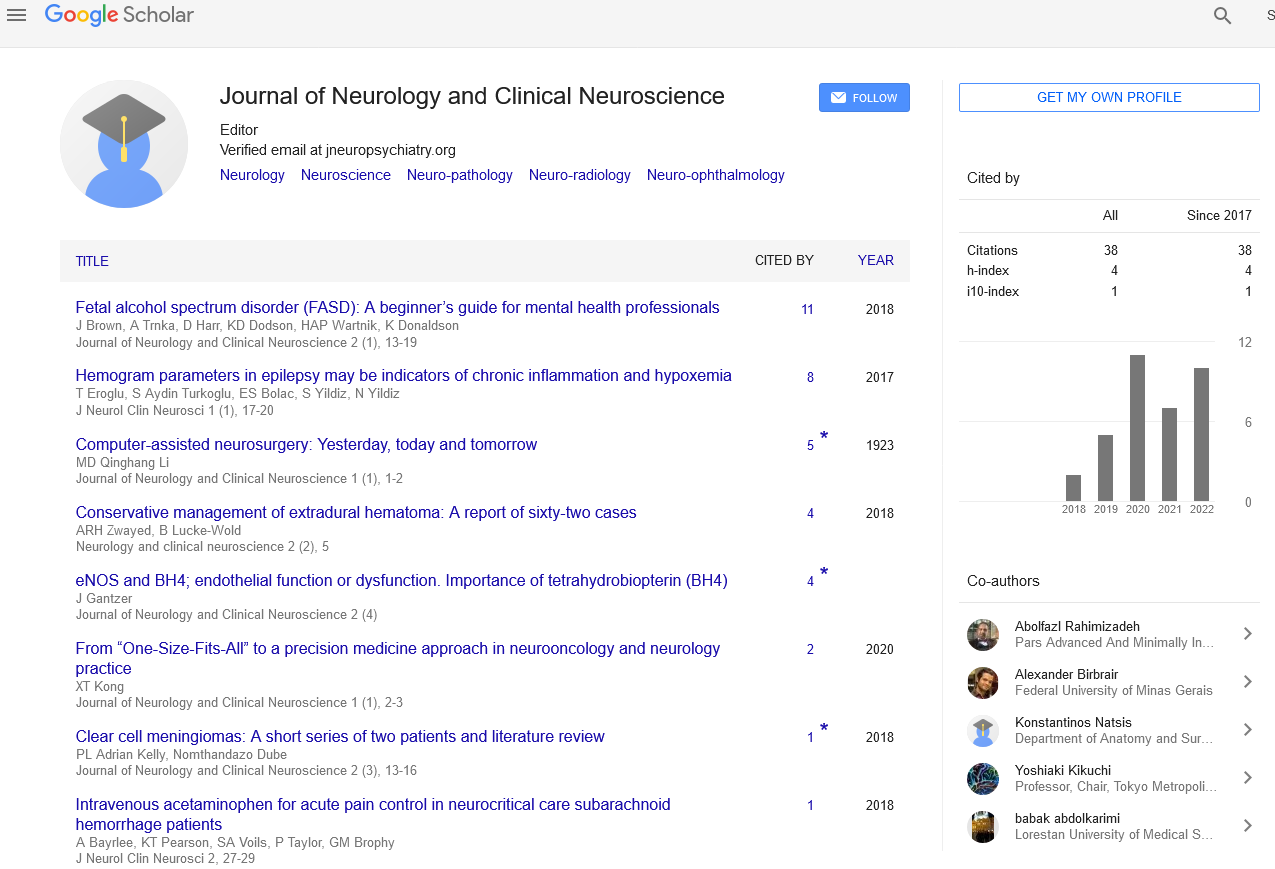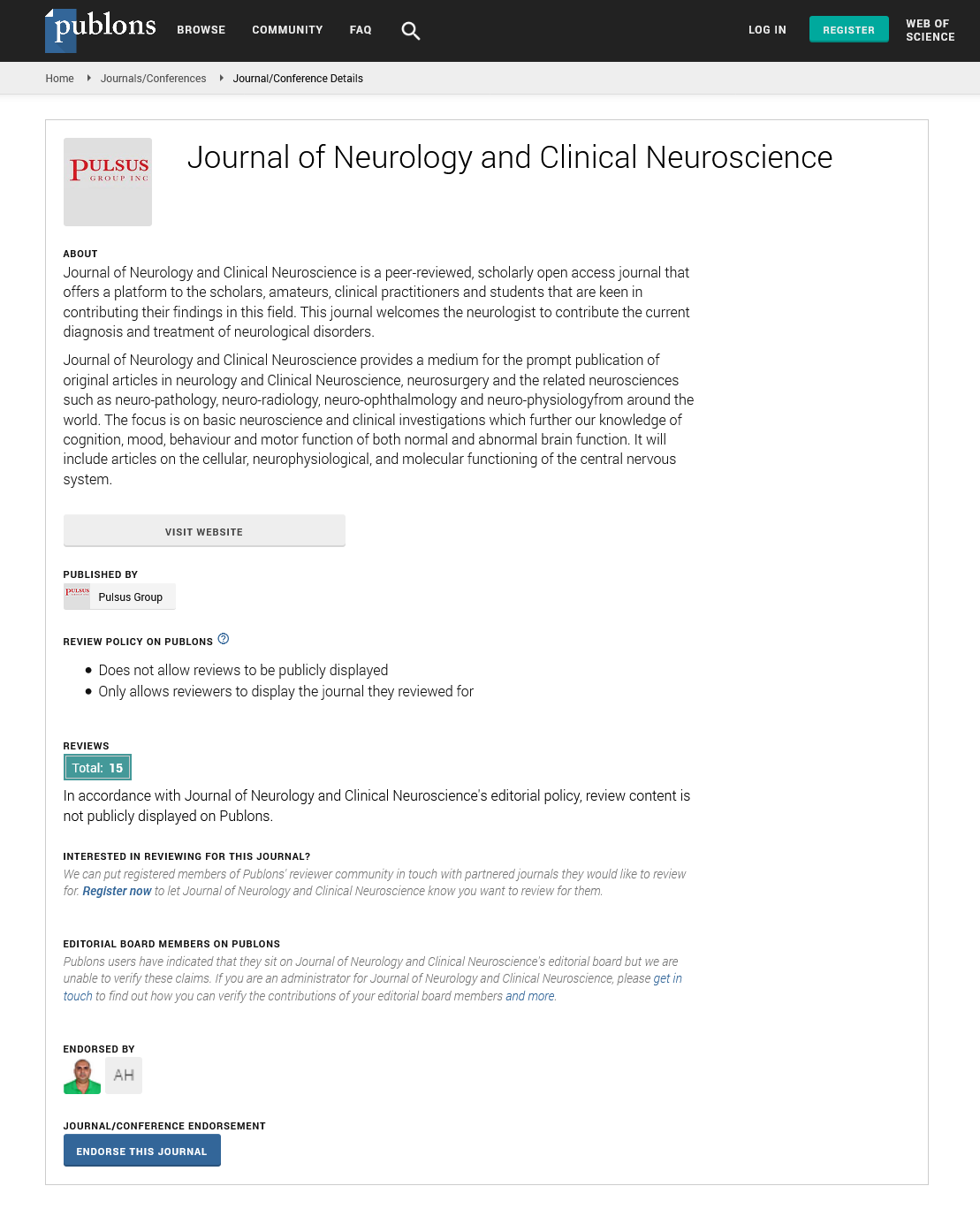European pediatric neurology society and committee of national advisors on paediatric neurology organization
Received: 20-Sep-2022, Manuscript No. PULJNCN-22-5370; Editor assigned: 22-Sep-2022, Pre QC No. PULJNCN-22-5370 (PQ); Reviewed: 04-Oct-2022 QC No. PULJNCN-22-5370; Revised: 20-Jan-2023, Manuscript No. PULJNCN-22-5370 (R); Published: 27-Jan-2023
Citation: Jones M. European pediatric neurology society and committee of national advisors on paediatric neurology organization. J Neurol Clin Neurosci 2023;7(1):1-2.
This open-access article is distributed under the terms of the Creative Commons Attribution Non-Commercial License (CC BY-NC) (http://creativecommons.org/licenses/by-nc/4.0/), which permits reuse, distribution and reproduction of the article, provided that the original work is properly cited and the reuse is restricted to noncommercial purposes. For commercial reuse, contact reprints@pulsus.com
Abstract
A specialty known as Pediatric Neurology (PN) is dedicated to the diagnosis, thorough treatment, and research of disorders of the central and peripheral nervous systems from fetal life through adolescence. The European PN training programmed was created by the European pediatric neurology society and was made available in the European Pediatric Neurology Syllabus in 2002. This was crucial in getting the sub-specialty acknowledged by the European academies of pediatrics and neurology, and in 2003, the board of the European union of medical specialties recognized PN as a sub-specialty of pediatrics and neurology.
In order to further improve training and practice standards across Europe, the EPNS established the Committee of National Advisors (CNA) in 2004. The CNA is made up of representatives from national pediatric neurology associations. The EPNS Training Advisory Board (TAB) provides PN societies with country specific guidance and help when creating training and care systems. The EPNS Board and CNA approved the second revision of the pediatric neurology syllabus in 2019. In this article, we'll provide a general overview of the education received by Pediatric Neurology (PN) specialists, also known as pediatric neurologists, as well as the relevant professional organizations and the state of pediatric neurology practice in Europe as it is currently understood by the World Health Organization(WHO).
Keywords
Pediatric; Neurology; Neuropsychiatry, Pediatric neurology
Introduction
With this article, we hope to provide a general overview of the education of Pediatric Nurology (PN) experts, also known as pediatric neurologists, the relevant professional organizations, and the present state of PN practice in Europe, as defined by the World Health Organization (WHO). In order to assess the state of training and care in PN in Europe, the Board of the European Pediatric Neurology Society (EPNS) and the Committee of National Advisors to the EPNS board (CNA) formed a working group. This article is meant to act as a reference for nations developing, organizing, or creating PN training. We suggest using it as a basis for improving the European PN Syllabus (the EPNS-established European PN training programmed) and for the future design of PN training at the European regulatory level. The study of normal and pathological central and peripheral nervous system development from fetal life through adolescence is the focus of the medical specialty known as PN. It focuses primarily on the holistic management of the resulting disabilities as well as the diagnosis, prevention, and treatment of disorders of these systems [1].
Additionally, PN experts are committed to this field's research as well as the dissemination of information through education and training initiatives. Finally, they focus on moral and societal concerns that pertain to neurologic illnesses in the pediatric population [2].
Literature Review
Data were gathered from three sources
• Information on pediatric neurology practice, organizations, and training in several European countries was gathered using an online structured database and form.
• TAB reports and evaluation visit findings.
• A review of the literature to determine published information on PN care and training.
European map of pediatric neurology
Members of the EPNS board and CNA representatives were invited to add data into the online database. Names of the national society (is), contact information (names, e-mail addresses of the Presidents, Secretaries, and CNA representative), website information for any linked PN magazine, society membership, and EPNS members from the various nations are all included in Section 1. Included in Section 2 are the specialty status of the PN, the type of specialization (core or subspecialty), and the year the PN received national recognition [3,4].
Section 3 provides details on training, including the entry point, the curriculum/component modules and their duration, tutoring, the examination and certification at the conclusion of training, academic posts, research, and funding options for research.
Section 4 contains information on the cost of care, population demographics, and the definition of a child's age, the number of PN specialists, the range of conditions referred to PN specialists, the levels of care available, and the nature of pediatric neurologists' work.
Tab visit report
The TAB visit reports were used to compile information on training and healthcare organization in various nations. Representatives of CNA checked to see if the data in the TAB reports was still accurate and made the necessary database modifications. In November 2019, the database analysis was completed [5].
Search the literature for information on how to become a PN specialist
A PubMed search was conducted to find articles about PN education and care delivery. Pediatric/child neurology OR pediatric/child neurology AND training AND curriculum were the search criteria. To enable comparison, articles addressing various aspects of PN training in Europe and the United States of America (USA) were chosen.
Organization of PN experts in European nations
38 European nations have at least one PN Society; however, due to the dearth of PN professionals, Ice land and the Republic of Moldova do not have a PN society. Armenia reported having a 15 person’s informal discussion group. The British pediatric neurology association officially recognizes an unofficial PN group in Ireland. The National Association of Neurologists in Azerbaijan includes PN specialists. There are two societies: One for pediatric neurologists and one for pediatric neurologists and psychiatrists in Italy and Romania, both of which have a history of having neuropsychiatry for children as a specialty (this specialty still exists in Italy) [6,7].
Results
CNA representatives from 43 different nations responded. The arrangement of care and PN training vary amongst European nations. PN specialists see children in the majority of European nations from fetal life until they are 18 years old. Children are seen up to the age of 16 in other nations like Finland, Belgium, and Switzerland, but only up to the age of 14 in Spain. Between Georgia and the United Kingdom (UK), the expected number of PN specialists for the population treated ranged from 1/3000 children to 1/173.000 children. This reflects variations in PN expert roles between nations [8].
Discussion
In Europe, pediatric neurology emerged from pediatrics and neurology as an interdisciplinary field of study. This historical context is represented in the entry to the PN programmed, which involves core training in neurology or pediatrics in seventeen different European nations, followed by PN specific training modules and rotations in the other mother specialty. While pediatrics is the only mother specialty in 18 nations, neurology is the preferred route in the Russian federation and Azerbaijan.
More children with serious neurological problems are moving from pediatric to adult care as medical care advances. Therefore, understanding of these disorders' long-term adult care is necessary [9,10].
Pediatric neurologists should become familiar with adult neurological illnesses, which frequently have discrete symptoms that first appear in childhood, and how their presentations and consequences alter with age from adult neurologists. In preparing patients and their families for the transition into adult life and care, PN specialists play a significant role. For PN and neurology doctors, communication and having a common language are essential.
The majority of pediatricians and neurodisability experts who treat children with neurological diseases at the secondary level will refer patients to PN specialists for diagnostic or therapeutic guidance. This service organization runs the danger of delaying referral to tertiary level specialists if doctors treating children with neurological disease at the secondary level lack the necessary training to identify disorders, particularly rare neurological diseases. The allied specialty of developmental neurology will play a substantial part in the certified pediatric neurologist's work in many nations, especially those with a relatively high number of PN experts per child capita. In areas with a shortage of child psychiatrists, this will include all matters relating to intellectual disability, motor deficiencies, and developmental behavioral disorders. Thus, the number of pediatric neurologists in a nation reflects both the prevalence of children with neurological disorders and the specifics of their field of practice. The majority of nations lack a mechanism for determining the required number of new PN resident positions each year.
The field of PN is evolving quickly with the development of contemporary neuroimaging, metabolomics, and neurogenesis, our diagnostic abilities have dramatically improved in the twenty-first century. Numerous novel vtreatments are being created, and the underpinnings of complicated neurological diseases are being uncovered. For kids with neurodisabilities, new technology will create a lot more options to enhance their quality of life. The emergence of the gene therapy era means the pediatric neurologist is at the center of decision making for transformative medicines. Within the last five years, the clinical management of neuromuscular disease has undergone a significant transformation, and similar changes are likely to affect the way pediatric neurology is practiced in other areas as well.
Conclusion
Pediatrics and neurology both developed into due to training requirements, neurology is still an international field. These two mothers have different disciplinary (sub) specialties.
The official status of PN as a (sub) specialty in Europe continues to vary by country, as do training requirements and entry points.
The EPNS has assisted national societies in developing training programmers and supporting their communications with national ministries of health through Training Advisory Board (TAB) visits, and it can do so in the future.
The EPNS PN syllabus has been adopted by many nations, and their PN training curricula often include rotations in pediatrics and adult neurology. Further debate should be had over the length of rotations.
The development of PN training in nations that desire to advance PN should be based on the European PN curriculum, which suggests a minimum of five, but ideally six, years of training to become a PN specialist.
A multidisciplinary approach is essential, as seen by the growth of highly specialized care facilities, such as those for epilepsy surgery, neuromuscular diseases, metabolic medicine, and sleep medicine.
Systems for ensuring that training and competency assessments are standardized in Europe should be established alongside novel tactics for influencing the growth of the specialty.
References
- Millichap JJ, Millichap JG. Child neurology: Past, present, and future: part 1: history. Neurology. 2009;73(7):31-3.
- Lesny I. History of Paediatric Neurology: a brief review. J Hist Neurosci. 1995;4(1):25-6.
- Brandt S. A European study group on child neurology. Neuropadiatrie. 1970;2(2):235-38
[Crossref] [Google Scholar] [PubMed]
- Harel S. Pediatric neurology in Israel. J Child Neurol. 10 (2000):688-89.
[Crossref] [Google Scholar] [PubMed]
- Kyllerman M, KennedyEur C. Newsletter EPNS, Summary of the minutes of the EPNS board meeting October 22, 2003. J Paediatz Neurol. 2004;8: 117-19.
- Stumpf DA. The founding of pediatric neurology in America. Bull N Y Acad Med. 1981;57(9):804.
[Google Scholar] [PubMed]
- Ridel KR, Gilbert DL. Child neurology: past, present, and future: part 3: the future. Neurology. 2010;75(15):62-4.
[Crossref] [Google Scholar] [PubMed]
- Ferriero DM, Pomeroy SL. The evolution of child neurology training. Pediatr. Neurol. 2017;66:3-4.
[Crossref] [Google Scholar] [PubMed]
- Greenwood RS. Changing child neurology training: evolution or revolution. J Child Neurol. 2012;27(2):264-66.
[Crossref] [Google Scholar] [PubMed]
- Gilbert DL, Horn PS, Kang PB, et al. Child neurology recruitment and training: views of residents and child neurologists from the 2015 AAP/CNS workforce survey. Pediatr Neurol. 2017;66:89-95.
[Crossref] [Google Scholar] [PubMed]





